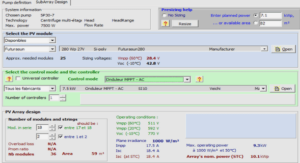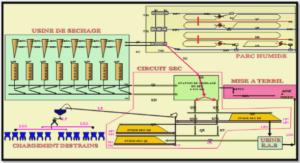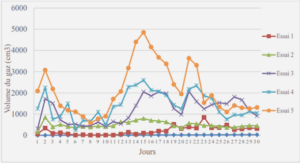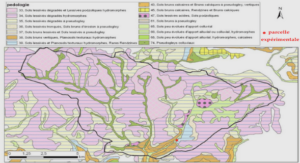Trembling aspen (Populus tremuloides Michx.)
Trembling aspen (Populus tremuloides Michx.), a member of the Salicaceae family, is a deciduous tree species widely distributed over the Northern Hemisphere (Bradshaw et al., 2000). Aspen stands play an important role in maintaining ecosystem biodiversity by providing nutrition and habitat for a number of species (Griffis-Kyle and Beier, 2003).
Aspens are dioecious, wind-pollinated, and produce large numbers of wind-dispersed seeds. Successful seed germination requires favorable moisture conditions, absence of competition, and availability of exposed mineral soil. However, these conditions allowing new seedling recruitment rarely occur at the same time (Romme et al., 2005). Sorne even suggested that massive colonization of vast areas through seedling establishment has not occurred in North America since the end of the last glacial period 10 000 years ago (Kemperman, 1976). Vegetative propagation from root suckering, thus, remains the prevailing mode of reproduction making aspen a donal tree species.
Rapid aspen regeneration occurs after either man-made or natural disturbances such as fires, outbreaks of insects, or gaps created by fallen trees (Bergeron, 2000).
Release of apical dominance following the tree removal allows sucker initiation from the shallow lateral roots that were left in the ground after the disturbance (Frey et al., 2003). Vegetative reproduction of aspen leads to the formation of a clone or genet that can be composed of several trees termed ramets (Scrosati, 2002).
Clone identification
Identification of clones can be done based on similarities in phenotype or genotype among individuals. Ideal phenotypic or genotypic criteria used for clone identification should exhibit a large variation among clones and be highly consistent within clones. As not a single phenotypic feature was sufficient to provide enough variation, a combination of a few was traditionally used (Bames, 1966; Bames, 1969; Kemperman, 1976; Barnes and Han, 1993). Ideal criteria should be also insensitive to environmental factors. Sorne morphological characteristics were traditionally assessed only categorically and such characterization has nowadays been abandoned as being too subjective. Value of other morphological traits was questioned for being influenced by environmental factors (Pers son and Gustavsson, 2001; Rumpunen and Bartish, 2002; Lopez-de-Heredia et al., 2004). Recently, molecular markers have become the method of choice in most population studies (Wyman et al. , 2003; Namroud et al., 2005; Suvanto and Latva-Karjanmaa, 2005; Mock et al., 2008; De Woody et al., 2009; Jelinkova et al., 2009; Liesebach et al., 2010).Nonetheless, morphological trait assessment had several advantages over the use of molecular markers. It was mainly the rapidity and ease of use directly in the field without the need of any laboratory analyses. Development of new methods for evaluation of various biological shapes in animais and plants brought also new possibilities for clone delineation (McLellan and Endler, 1998; Jensen et al., 2002; Neto et al., 2006; Viscosi and Fortini, 2011; Cope et al., 2012).
Genotype conservation and aspen root system
Clonai diversity in species with limited sexual reproduction tends to diminish over time (Balloux et al., 2003). Despite the limited recruitment of seedlings, aspen remains one of most diverse tree species letting stranded those who tried to find a decline of clonai richness during succession (Erickson and Hamrick, 2003; Pluess and Stocklin, 2004; Namroud et al., 2005). In the second chapter, we sought an additional mechanism of diversity maintenance in aspen clonai root network.
Shallow root systems of aspens comprise the principal and thin lateral roots. They are mainly the lateral roots that initiate new suckers. Aspen trees that have regenerated from the root suckers remain connected to the original parental roots even after reaching maturity (Des Rochers and Lieffers, 2001 ). Besicles, aspen root systems often include surviving roots of dead stumps grafted to roots of living stems (DesRochers and Lieffers, 2001 ). It is not known wh ether the se grafts occur only between roots of the same genotype or whether they could be also established between trees of different clones. Montalvo and his colleagues (Montalvo et al., 1997) found that sorne interconnected trees of another donal tree species, Quercus chrysolepis, differed in genotypes. Moreover, many aspen clones are often intermingled at the same site (Wyman et al., 2003; Namroud et al., 2005; Suvanto and Latva-Karjanmaa, 2005). These findings suggest that different genets of an aspen stand might be linked by their root systems and could include roots of unique genotypes that are not present among the stems.
Plant defenses against herbivores and herbivore-simulated wounding
Trees have efficient defense mechanisms (Philippe and Bohlmann, 2007; Duplessis et al., 2009; Ralph, 2009; Barton and Koricheva, 2010) that can be divided into two types; constitutive defense mechanisms are permanently at work even in absence of potential threats (Robison and Raffa, 1997; Philippe and Bohlmann, 2007; Brilli et al., 2009), whereas, inducible defenses occur only after pathogen or herbivore attack triggering off the defense responses (Metraux et al., 2002; Philippe and Bohlmann, 2007; Germain and Seguin, 2011 ). Sorne defense mechanisms effect herbivores directly by producing toxins or other substances that change the tissue quality (Lindroth, 2001; Osier and Lindroth, 2001; Bailey et al., 2007; Donaldson and Lindroth, 2008). Other defense mechanisms may tackle the herbivores in an indirect way by releasing gaseous chemicals called volatiles that attract the natural enemies of the herbivores (Parry et al., 2003; Arimura et al., 2004; Brilli et al., 2009).
The induced defense mechanisms can be either confined to the damaged site or spread to rem ote unaffected parts of the plant. This phenomenon is referred to as induced systemic resistance (ISR; Metraux et al., 2002). After recognition of an initial stimulus (herbivory) by the plant, a signal transduction pathway is switched on resulting in activation of defense mechanisms. These defense mechanisms principally involve expression of new genes (Haruta et al., 2001a; Haruta et al., 2001b; Peters and Constabel, 2002; Arimura et al., 2004; Christopher et al., 2004; Wang and Constabel, 2004; Ralph et al., 2006; Tsai et al., 2006; Philippe et al., 2009; Philippe et al., 2010).
Defense signaling in a clonai plant species
Herbivory feeding (or herb ivory simulation by wounding) initiates production of defense induction signais at the site of the damage. These signais then spread throughout the plant body and trigger off the systemic defense mechanisms (Metraux et al., 2002). The nature of these signais is not well understood, nonetheless sorne factors influencing their movement are known. For instance, it is clear that signal transmission is limited by plant vascular architecture (Jones et al., 1993). The vascular architecture of trembling as pen is ortosticious, which me ans that a selected leaf alongside the stem is directly connected to the eighth leaf growing upward or downward from the selected one. These leaves share direct vascular connection, and, thus, signal transmission among these leaves is not limited by vascular connectivity.
Moreover, it has been demonstrated that the movement of the defense induction signais is influenced by the source and sink relationship within the plant body (Arnold et al., 2004; Arnold and Schultz, 2002). As fast growing young leaves at the top of stems represent the strongest sinks for assimilates, strong systemic defense induction was detected particularly in these leaves. However, herbivory feeding modifies the flow of assimilates through the plant body partially diverting carbohydrates to roots (Babst et al., 2005; Babst et al., 2008).
|
Table des matières
INTRODUCTION
STATE OF THE ARTS
Trembling aspen (Populus tremuloides Michx.)
Clone identification
Genotype conservation and aspen root system
Physiological integration
Plant defenses against herbivores and herbivore-simulated wounding
Defense signaling in a clonai plant species.
METHODS
OBJECTIVES AND EXPERIMENTAL APPROACH
CHAPTER I :THE USE OF DIGITAL MORPHOMETRICS AND SPRING PHENOLOGY FOR CLONE RECOGNITION IN TREMBLING ASPEN (POPULUS TREMULOIDES MICHX.) AND ITS COMPARISON TO MICROSATELLITE MARKERS
1.1 RÉSUMÉ
1.2 ABSTRACT
1.3 INTRODUCTION
1.4 MATHERIALS AND METHODS
1.4.1 Study Sites
1.4.2 Microsatellite Characteristics
1.4.3 Leaf Shape Description
1.4.4 Leaf Shape Analysis
1.4.5 Phenological and Bark Characteristics
1.5 RESULTS
1.5.1 Microsatellite Characteristics
1.5.2 LeafShape Characteristics
1.5.3 Phenological and Bark Characteristics
1.6 DISCUSSION
1.7 CONCLUSION
1.8 ACKNOWLEDGEMENTS
1.9 LITERA TURE CITED
CHAPTER II :MOLECULAR AND DENDROCHRONOLOGICAL ANALYSIS OF NATURAL ROOT GRAFTING IN TREMBLING ASPEN (SALICACEAE)
2.1 RÉSUMÉ
2.2 ABSTRACT
2.3 INTRODUCTION
2.4 MATERIALS AND METHODS
2.4.1 Study Area
2.4.2 Excavation and Sampling
2.4.3 Dendrochronological Analysis
2.4.4 Clone Identification
2.5 RESULTS
2.5.1 Clone Identification
2. 5.2 Natural Root Grafting
2.5.3 Living Roots on Dead Stumps (LRDS)
2.5.4 Clonai Integration
2.6 DISCUSSION
2.7 ACKNOWLEDGEMENTS
2.8 LITERA TURE CITED
CHAPTER III :HERBIVORE-SIMULATED INDUCTION OF DEFENSES IN CLONAL NETWORKS OF TREMBLING ASPEN (POPULUS TREMULOIDES)
3.1. RÉSUMÉ
3.2 ABSTRACT
3.3 INTRODUCTION
3.4 MATERIALS AND METHODS
3. 4.1 Plant material
3.4.2 Stress treatment simulating insect herbivory
3.4.3 Selection of target genes and normalization standards
3.4.4 Primer and TaqMan probe design
3.4.5 Quantitative real-time PCR assay
3.4.6 Data analysis and statistics
3.5 RESULTS
3.5.1 Expression of KTI
3.5.2 Expression of DFR
3.6 DISCUSSION
3.7 CONCLUSION
3.8 ACKNOWLEDGEMENTS
3.9 LITERA TURE CITED
GENERAL CONCLUSION
![]() Télécharger le rapport complet
Télécharger le rapport complet





